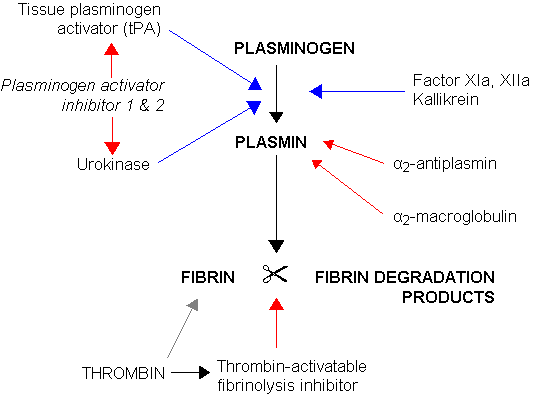Tissue plasminogen activator
| Plasminogen activator, tissue | |||||||||||
|---|---|---|---|---|---|---|---|---|---|---|---|
 PDB rendering based on 1a5h. | |||||||||||
| Identifiers | |||||||||||
| Symbols | PLAT ; DKFZp686I03148; T-PA; TPA | ||||||||||
| External IDs | Template:OMIM5 Template:MGI HomoloGene: 717 | ||||||||||
| |||||||||||
| RNA expression pattern | |||||||||||
 | |||||||||||
| More reference expression data | |||||||||||
| Orthologs | |||||||||||
| Template:GNF Ortholog box | |||||||||||
| Species | Human | Mouse | |||||||||
| Entrez | n/a | n/a | |||||||||
| Ensembl | n/a | n/a | |||||||||
| UniProt | n/a | n/a | |||||||||
| RefSeq (mRNA) | n/a | n/a | |||||||||
| RefSeq (protein) | n/a | n/a | |||||||||
| Location (UCSC) | n/a | n/a | |||||||||
| PubMed search | n/a | n/a | |||||||||
Editor-In-Chief: C. Michael Gibson, M.S., M.D. [1]
Overview
Tissue plasminogen activator (abbreviated PLAT or tPA) is a serine protease normally found on the surface of endothelial cells of veins, capillaries, the pulmonary artery, heart, and uterus, and is secreted after vascular injury. It converts the proenzyme plasminogen to plasmin, a fibrinolytic enzyme. Plasminogen is synthesized as a single chain, which is cleaved by PLAT into the two chain disulfide linked plasmin.
Function
This enzyme plays a role in cell migration and tissue remodeling. Increased enzymatic activity causes hyperfibrinolysis, which manifests as excessive bleeding; decreased activity leads to hypofibrinolysis which can result in thrombosis or embolism.

Gene
Alternative splicing of the PLAT gene, PLAT, produces three transcripts.
Clinical applications
Recombinant PLAT is used in diseases that feature blood clots, such as myocardial infarction and stroke. To be effective, PLAT must be administered within the first three hours of the event to be given intravenously, or within six hours to be administered through an arterial catheter directly to the site of occlusion. The guideline in Ontario, Canada hospitals for ischemic strokes is that tPA must be given within 3 hours of the onset of symptoms. Because of this, only about 3% of patients qualify for this treatment. TPA appears to show benefit not only for large artery occlusions but also for lacunar strokes. Since PLAT dissolves blood clots, there is risk of hemorrhage with its use.
Recently tPA has been used to dissolve thrombi associated with ischemic strokes and brain injury.
In addition, people with frostbite that were treated with tPA had fewer amputations than those that were not[1].
Further reading
- Rijken DC (1988). "Relationships between structure and function of tissue-type plasminogen activator". Klin. Wochenschr. 66 Suppl 12: 33–9. PMID 3126346.
- Bode W, Renatus M (1998). "Tissue-type plasminogen activator: variants and crystal/solution structures demarcate structural determinants of function". Curr. Opin. Struct. Biol. 7 (6): 865–72. PMID 9434908.
- Collen D, Billiau A, Edy J, De Somer P., Identification of the human plasma protein which inhibits fibrinolysis associated with malignant cells, Biochim Biophys Acta. 1977 Sep 29;499(2):194-201
- Anglés-Cano E, Rojas G (2003). "Apolipoprotein(a): structure-function relationship at the lysine-binding site and plasminogen activator cleavage site". Biol. Chem. 383 (1): 93–9. PMID 11928826.
- Ny T, Wahlberg P, Brändström IJ (2003). "Matrix remodeling in the ovary: regulation and functional role of the plasminogen activator and matrix metalloproteinase systems". Mol. Cell. Endocrinol. 187 (1–2): 29–38. PMID 11988309.
- Teesalu T, Kulla A, Asser T; et al. (2002). "Tissue plasminogen activator as a key effector in neurobiology and neuropathology". Biochem. Soc. Trans. 30 (2): 183–9. doi:10.1042/ Check
|doi=value (help). PMID 12023848. - Pang PT, Lu B (2005). "Regulation of late-phase LTP and long-term memory in normal and aging hippocampus: role of secreted proteins tPA and BDNF". Ageing Res. Rev. 3 (4): 407–30. doi:10.1016/j.arr.2004.07.002. PMID 15541709.
- Sheehan JJ, Tsirka SE (2005). "Fibrin-modifying serine proteases thrombin, tPA, and plasmin in ischemic stroke: a review". Glia. 50 (4): 340–50. doi:10.1002/glia.20150. PMID 15846799.
References
- ↑ Template:Web cite Reduction of the Incidence of Amputation in Frostbite Injury With Thrombolytic Therapy, Bruen et al., 2007;142:546-553.
See also
External links
- http://www.americanheart.org/presenter.jhtml?identifier=4751
- Widening the Window : Strategies to buy time in treating ischemic stroke - Scientific American Magazine (August 2005)
de:Gewebespezifischer Plasminogenaktivator
nl:Tissue plasminogen activator